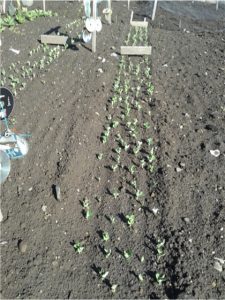The Allotment Year 2021
Following on from The Allotment Year 2020, these two allotment plots have been cultivated by the same family for near on 50 years. Cultivations continue in the traditional allotment style using the three-year crop rotation system.
This year we will look at the cultivation of individual crops. I use traditional methods which has proved successful over the last fifty years.
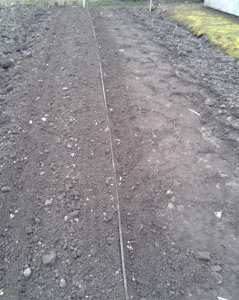 Starting with Parsnips – The seed bed is prepared, by deep forking , no organic matter is added to prevent the parsnips splitting. The seed bed is firmed, when soil is moist but not sticky, by ‘boot shuffling’, slowly walking across the bed firming with your boots.
Starting with Parsnips – The seed bed is prepared, by deep forking , no organic matter is added to prevent the parsnips splitting. The seed bed is firmed, when soil is moist but not sticky, by ‘boot shuffling’, slowly walking across the bed firming with your boots.
This is followed by raking to obtain a fine tilth and then a seed drill is formed with corner of rake, about half an inch deep. A few seed (six the ten) are placed at stations every 9/12 inch apart, on germination seedlings thinned to one plant.
The soil is then pulled back, using your fingers to lightly fill the drill, firmed with back of rake to ensure seed is in contact with the soil. The photo (20/3/21) left shows the process.
Line marks the row with seed visible, area to right firmed ready for next row.
Next we move on to potatoes. The photo to the right shows the first early potatoes being planted in late March.
Firstly a trench is excavated one ‘spit’ wide by spade depth deep.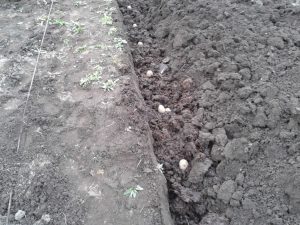 (Spit being the width of the spade). Well rotted manure is placed in bottom of trench and then working back to line, two foot from previous trench soil is dug over the potatoes. (early varieties 12 to 15 inch apart in row. Second early and main crop 15 to 18 inch apart) I usually covers potatoes with fine soil scrapped from area to be dug prior to digging over.
(Spit being the width of the spade). Well rotted manure is placed in bottom of trench and then working back to line, two foot from previous trench soil is dug over the potatoes. (early varieties 12 to 15 inch apart in row. Second early and main crop 15 to 18 inch apart) I usually covers potatoes with fine soil scrapped from area to be dug prior to digging over.
I also add manure to next ‘spit’. Before digging back to line ready for next row of potatoes. The well rotted manure is shown in picture below. This is horse manure purchased from a local farmer in October previous year placed in compost area and sheeted over until used following spring.
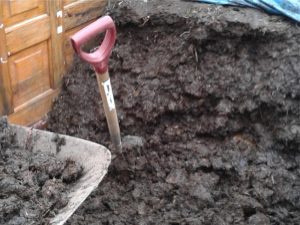
Please refer to previous posts during 2020 for more information on the ‘Allotment Year’.
John Palmer
Next we will look at the cultivation of peas and beans:
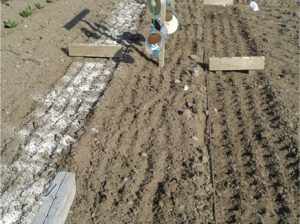 The photo left shows the sowing of Peas – in this case the variety is ‘Kelvedon Wonder’ an good early cropper. The date of sowing is 3rd April. The soil needs to well manured and in a dry enough condition to allow cultivation. I plant my legume crops (peas/beans) on the area used the previous season for potatoes, which was dug over following harvest of the crop. Ensure the soil is firm, usually the winter weather will ensure this. If not use ‘boot shuffling’ explained in last instalment.
The photo left shows the sowing of Peas – in this case the variety is ‘Kelvedon Wonder’ an good early cropper. The date of sowing is 3rd April. The soil needs to well manured and in a dry enough condition to allow cultivation. I plant my legume crops (peas/beans) on the area used the previous season for potatoes, which was dug over following harvest of the crop. Ensure the soil is firm, usually the winter weather will ensure this. If not use ‘boot shuffling’ explained in last instalment.
Using fork or cultivator to prepare a strip about a foot wide to a depth of about 2/3 inches deep. The pea seed is then pressed into the soil and inch or so deep 2/3 inches apart in four rows. Then use fork to level off the area of planting. I then give a dressing of garden lime to deter mice! The wooden frames seen are to support cotton which is drawn across the length of the row and twisted around nails in each support to prevent bird damage.
Sowing French Beans – ‘The Prince’ on the 6th May. This is a crop I try 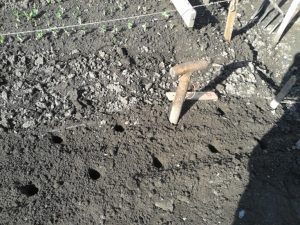
each year. It can be a little early and seedlings can be frost affected, however, I feel its worth the risk to get an early crop. Seed bed prepared as per peas above. Dibber holes, 9 inch apart double row, made 2 inch deep and a couple of seed placed in each. Level off with fork or rake. On germination take out or transplant additional seedlings to leave just one at each station.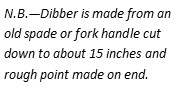
Please refer to previous posts during 2020 for more information on the ‘Allotment Year’.
John Palmer (8/5/21)
In this instalment of the ‘Allotment Year’ we look at the progress of the crops previously covered earlier in the season —all photos taken 1st June 2021.
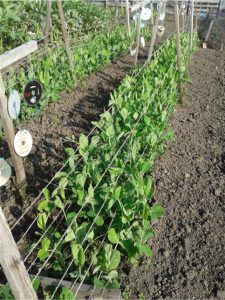 To left Peas—now growing well— strings stretched between wooden posts knocked in
To left Peas—now growing well— strings stretched between wooden posts knocked in 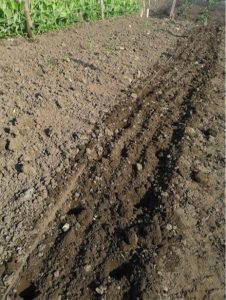 ground along row as support.
ground along row as support.
To right—French bean sown 6th May— late germination due to cold conditions just a few emerging. Now sowing main crop of French Bean ‘ Tendercrop’ – two double rows sown. (On the 8th June germination starting—warmer soil!)
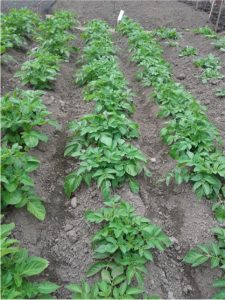
To left—potatoes growing well—earthed up on the 25th May following application of
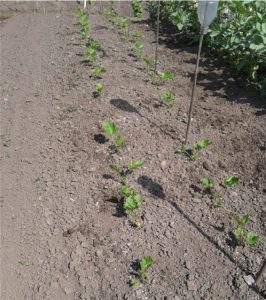
‘growmore’ fertilizer.
To Right —parsnip—two rows good germination and growing well. Other rows sown on same
date 20th March—no germination and now re-sown.
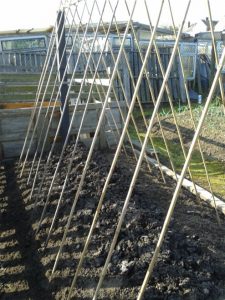 Left—Runner Bean area—8 foot canes form the support pushed into soil and tops
Left—Runner Bean area—8 foot canes form the support pushed into soil and tops
secured to wooden cross piece between permanent support posts. This area grows runner beans annually. The manure placed on top under the arch acts as a mulch this year and then deeply dug in during the winter. Every other year I double dug (this entails moving the top spade depth and then deep forking the second spade depth. There is now almost two feet of top soil on the area. Two or three seeds and then pushed into the soil about 2 inch deep around the base of each cane.
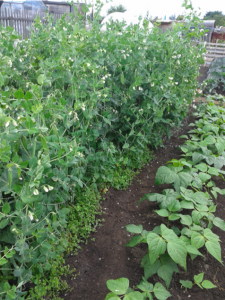
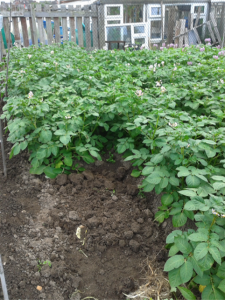
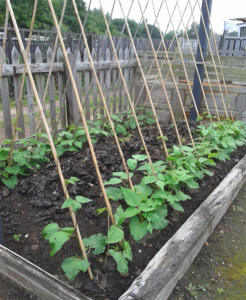
In this instalment of the ‘Allotment Year’ looks at the progress of the crops previously covered earlier in the season —all photos taken 29th June 2021.
To left Peas— flowering well and pods forming. Expecting to start harvesting in early July.
To right—French bean left hand row sown 6th May ‘The Prince’ — late germination due to cold conditions. Lower rows ‘ Tendercrop’ sown 1st June—already caught and passing earlier sowing!
To left—potatoes—first early ‘Arran pilot’ now being harvested.
Left—Runner Bean area — Two or three sown at base of each cane 1st June— good germination and now starting to twine up the canes.
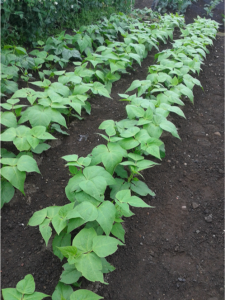
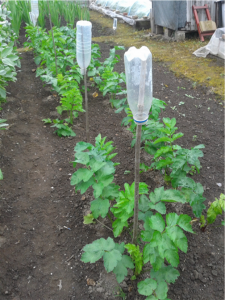
Above —parsnip—two rows good germination and growing well. Very poor germination and area re-cultivated for salad crop.

